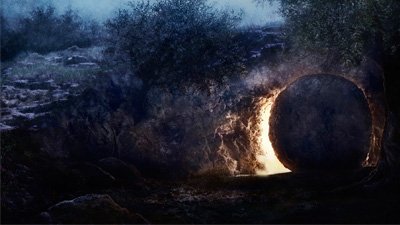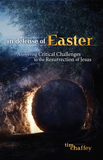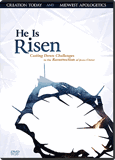
Seeing Things
Tim Chaffey, AiG–US, critiques two of the critical views popularized by liberal theologians that at least wrestle with some of the evidence.
The first few articles in our series on the Resurrection described the centrality of this doctrine to the Christian faith and explored many of the evidences that Jesus rose from the dead. The most recent article critiqued three alternative views raised by skeptics in attempts to deny this great miracle. Proponents of the mistaken identity, legend, and copycat views essentially ignore all of the evidence and push baseless theories instead.
In today’s article we will critique two of the critical views popularized by liberal theologians that at least wrestle with some of the evidence. As such, they do a better job of dealing with the historical data than the skeptical positions, yet as we will see, they still cannot account for all of the five key evidences.
Mass Hallucinations
One of the infallible proofs of Christ’s Resurrection is the fact that He repeatedly appeared to people after being crucified. As previously demonstrated, the vast majority of historians accept as fact that the disciples believed Jesus had appeared to them, which led to their bold proclamations that He had risen from the dead. Within the biblical worldview, the obvious explanation for these appearances is exactly what the Bible states—Jesus died, was buried, and then rose again (1 Corinthians 15:3–8). However, this conclusion does not sit well with liberal theologians and other skeptics and critics because of the obvious implications. That is, if Jesus rose from the dead as He predicted He would, then this event would confirm His teachings, and this is unacceptable for those who do not want to trust in Christ.1
Throughout history individuals have experienced hallucinations, meaning that they have perceived someone or something to be present even though that person or thing was not objectively there. Hallucinations are common among certain types of drug users and among those who are grieving the loss of a loved one. The disciples were certainly grieving over the death of Christ, so critical theologians have argued that the disciples may have simply experienced hallucinations of Jesus, causing them to conclude that He had risen from the dead. This theory, or some variation of it, has actually been proposed by numerous critical scholars and currently is their leading alternate explanation to the Resurrection.
Michael Goulder (1927–2010) was a liberal biblical scholar who refers to Peter’s devastated psychological and emotional state after Jesus was crucified as the basis for a grief-induced hallucination. He then told the other disciples about this event and they shared in a group delusion, similar to some of the purported sightings of Mary or UFOs.2
Atheist Gerd Lüdemann (b. 1946) has promoted a similar idea. After experiencing a hallucination of Jesus stemming from his mental torment, Peter informed the other disciples, who subsequently shared a group hallucination. Lüdemann’s bias against supernatural activity is a driving force in his interpretation of the data. He stated that it is nonsensical to believe that Jesus rose physically from the dead because one would have to believe that a decaying corpse, already cold and without blood in its brain, could be made alive again.3
Although it is true that many grief-stricken people are prone to hallucinate, there are multiple problems with these explanations regarding the appearances of Jesus. Concerning hallucinations today, only a small percentage can be described as vivid, and they are more common among women and the elderly. Additionally, there is essentially no support for the idea of a group hallucination.4 Yet these critics propose that a large group of younger men had a shared vivid hallucination of Jesus.
Henry Morris correctly pointed out some of the absurdities of this position.
Such hallucinations, if this is what they were, are quite unique and should warrant careful psychological scrutiny. These [supposed hallucinations of the disciples] were experienced by a considerable number of different individuals, all seeing the same vision, but in different groups, at different times, both indoors and outdoors, on a hilltop, along a roadway, by a lakeshore, and other places. Furthermore, they were not looking for Jesus at all. Several times they didn't recognize Him at first, and at least once actually believed it was a ghost until He convinced them otherwise. He invited them to touch Him and they recognized the wounds in His hands (John 20:27; Luke 24:39). They watched Him eat with them (Luke 24:41–43). On one occasion, over 500 different people saw Him at one time (1 Corinthians 15:6), most of whom were still living at the time when the evidence was being used.5
Still more problems exist for this popular skeptical view. How does one explain the appearance of Jesus to Paul on the road to Damascus? Surely Paul was not grieving over the death of Jesus. He was zealously persecuting followers of Christ and “still breathing threats and murder against the disciples
” (Acts 9:1). He was not in any state of mind to experience a hallucination of Jesus, particularly one that would transform his life so drastically. Yet Paul’s experience is one of the five key evidences, meaning it is well-evidenced and accepted by the vast majority of scholars on the subject.
Also among the key evidences are the empty tomb and the conversion of James due to a purported post-Resurrection appearance of Jesus. The mass hallucination theory cannot account for the empty tomb without appealing to another highly improbable theory, such as the reburial or stolen body views we will examine in the next article. Nor can the hallucination view make sense of the conversion of James. While James may have grieved the loss of his half-brother, the death of Jesus would have confirmed his skeptical view of the Lord’s claim to be the Savior. Only upon seeing the risen Lord did James come to believe in Jesus as the Jewish Messiah.6
Even the non-Christian Pinchas Lapide rejected the hallucination theory. After examining the various claims he wrote, “If the defeated and depressed group of disciples overnight could change into a victorious movement of faith, based only on autosuggestion or self-deception—without a fundamental faith experience—then this would be a much greater miracle than the resurrection itself.”7
Lapide is correct. So, the famous anti-miraculous dictum of David Hume (the eighteenth-century skeptical philosopher) can be turned around on the skeptics. Hume argued that the wise man “proportions his belief to the evidence,”8 so he thought the evidence would always favor a naturalistic explanation over a supernatural one. Yet in this case, it would be a far greater miracle for entire groups of people in different mental states to undergo shared hallucinations on different occasions, in different places, and for different reasons.9
Visions
There are two strands of this view. In many respects, the naturalistic vision hypothesis is similar to the mass hallucination view and suffers from the same flaws. The supernatural vision hypothesis is different in that it still accepts a miraculous explanation for the events. Essentially, this view states that Jesus spiritually ascended into heaven, leaving His body in the tomb. From heaven Jesus used something akin to mental telepathy to transmit images of Himself to His disciples on earth. These visions were so vivid that the disciples assumed they were actually seeing the resurrected body of Jesus. This position has also been called the telegram or telegraph theory.10
As with each of these alternative views, the claim that the disciples mistook visions of Jesus for a bodily resurrection is seriously flawed. However, it does a better job of dealing with the historical facts than most of these views, so portions of this view are plausible. For example, several early Christians actually did experience supernatural visions: Stephen (Acts 7:55–56), Peter (Acts 10), Paul (Acts 16:9; 18:9), and John (virtually the whole book of Revelation). But can these types of visions really be confused with the physical appearances described in the Gospels and Acts 1?
No, the vision hypothesis cannot account for many of the historical facts. It does not adequately explain the handful of group appearances. By their very nature, visions are individualized incidents, so they are not shared experiences. Yet the Bible records that Jesus appeared to groups of people on several occasions (Luke 24:36; John 20:26–29; 21:1), including an appearance to more than 500 people at one time (1 Corinthians 15:6).
A distinction must be made between objective visions and subjective visions.11 An objective vision occurs when the natural senses are not employed, but the object being “seen” is real and not imaginary. Stephen’s experience of seeing Jesus at the right hand of God may be an example of an objective vision. If someone claims that the disciples had objective visions of Jesus, then they would be admitting that Jesus rose from the dead since the object being seen is real. Consequently, the objective vision is unacceptable to skeptics.
A subjective vision is a specific type of dream or hallucination in that it has a religious subject. Nevertheless, it is still simply “a product of our minds and has no cause or reality outside of our mind.”12 As such, the subjective vision hypothesis has the same problems as the hallucination proposals mentioned above.
Furthermore, the vision hypothesis (whether objective or subjective) does not account for the empty tomb, so adherents to this position must rely upon other untenable positions that claim someone moved Christ’s body or that everyone went to the wrong tomb (we will examine these views in forthcoming articles). Adding these untenable positions to the mix does not strengthen this position in any way—it substantially weakens the case.
Finally, this view does not adequately address the conversions of James and Paul. For example, proponents of this position often claim that Paul had a vision of Jesus on the road to Damascus. However, this account tells us that Paul’s traveling companions saw a light (Acts 22:9) and heard a voice (Acts 9:7).13 Visions, like dreams and hallucinations, are not shared experiences. Yes, multiple people can have visions and dreams, but they do not share in the same experience. So Paul’s encounter with the risen Christ cannot be explained away by appealing to the vision hypothesis.14
Conclusion
Although better in many respects than the other skeptical and critical positions attempting to deal with the historical data, the hallucination and vision views cannot account for all of all the key evidences. Neither can they properly account for the conversions of Paul and James, nor do they have an adequate explanation for the empty tomb. Hence, they must depend upon one of the improbable scenarios involving the moving of Christ’s body.
It is quite clear why skeptics will believe the most absurd ideas to explain away the Resurrection—they refuse to accept any supernatural events, particularly one in which the Son of God conquers death. This single event smashes their entire naturalistic worldview. But it is less clear why critical scholars are so reluctant to accept the plain words of Scripture on this subject. After all, these people often claim to be Christians, so their rejection of the Resurrection does not stem from an atheistic worldview. Yet the critics have still adopted an anti-biblical worldview and hold to more of a deistic view where God does not miraculously intervene in His creation. No matter what their reasons are for doing so, by rejecting the physical Resurrection of Christ, these critics have denied the heart of the gospel message, showing that they are not true Christians (Romans 10:9; 1 Corinthians 15:3–4; 12–19).
For both the skeptic and critic the solution is the same. They must repent of their sins and place their faith in the resurrected Lord and Savior Jesus Christ. While they may fear that this would be akin to committing intellectual suicide, we have seen the opposite is true. The bodily Resurrection of Jesus is corroborated by a wealth of demonstrably reliable historical facts and is taught in the eyewitness accounts in God’s infallible Word. To reject such a well-evidenced historical event is an anti-intellectual move and reveals a greater problem—an unwillingness to humble oneself before the Creator who sent His Son to die in our place and raised Him from the dead. Jesus paid the penalty for our sins so that we can live eternally with Him. To continue in the rebellion started by our first parents in the Garden of Eden is not only foolish, it is worse than intellectual suicide because the person who refuses the Savior’s sacrificial death consigns himself to a miserable, Christ-less eternity in the lake of fire (Revelation 20:11–15).
If you are an unbeliever, I urge you to continue studying the Resurrection of Jesus and plead with you to call upon the risen Savior for salvation. If you are a believer, please continue to pray for your unsaved friends and family members. If God can save the church’s greatest persecutor, Paul, then He certainly has the ability to reach your lost loved ones with the saving message of the gospel.
Footnotes
- A rare exception is found in the work of Orthodox Jewish writer Pinchas Lapide, who believed the evidence was so strong for the Resurrection that he wrote, “In regard to the future resurrection of the dead, I am and remain a Pharisee. Concerning the resurrection of Jesus on Easter Sunday, I was for decades a Sadducee. I am no longer a Sadducee.” He even criticized professing Christians who denied the Resurrection stating, “I cannot rid myself of the impression that some modern Christian theologians are ashamed of the material fact of the resurrection. Their varying attempts at dehistoricizing the Easter experience which give the lie to all four evangelists are simply not understandable in any other way.” Nevertheless, Lapide did not convert to Christianity.
- Michael Goulder, “Baseless Fabric of a Vision,” in Gavin D’Costa, ed., Resurrection Reconsidered (Oxford: Oneworld, 1996), 53.
- Gerd Lüdemann, “Opening Statement,” in Paul Copan and Ronald Tacelli, eds. Jesus’ Resurrection: Fact or Figment? (Downers Grove, IL: InterVarsity Press, 2000), 45.
- Michael R. Licona, The Resurrection of Jesus: A New Historiographical Approach (Downers Grove, IL: IVP Academic, 2010), 483–484.
- Henry Morris, Many Infallible Proofs (Green Forest, AR: Master Books, 1996), 103.
- As explained in the third article of this series, Scripture does not explicitly state that James converted upon seeing Christ. However, most scholars agree that his conversion occurred when he saw the risen Savior (or, from the critical viewpoint, when he believed he was witnessing the risen Christ). The Bible reveals that James rejected Christ’s claims prior to the Crucifixion (John 7:5), and just several weeks after Jesus died, James is counted among the believers in the upper room (Acts 1:14). What happened between these two events? Paul told the Corinthians that Jesus appeared to James alive and well after being killed and buried (1 Corinthians 15:7).
- Pinchas Lapide, The Resurrection of Jesus: A Jewish Perspective, 126).
- David Hume, An Enquiry concerning Human Understanding (Oxford, 2nd edition, 1902 reprint of 1777 posthumous edition), § 87.
- The skeptic may claim that any naturalistic explanation, no matter how absurd, always trumps a supernatural explanation, yet this reveals more about the person’s anti-supernatural bias than it does the evidence. Regarding the Resurrection of Jesus, there is strong historical evidence that Jesus died and was seen alive again. Also, there are no known examples of mass hallucinations or of mass visions, yet some of the eyewitnesses of the risen Savior had already seen at least three people raised from the dead (Luke 7:11–15; 8:49–56; John 11:37–44). Furthermore, Hume’s assertion ignores the fact that millions of people throughout history have claimed to have witnessed a miracle. Craig S. Keener, Miracles: The Credibility of the New Testament Accounts, volume 1 (Grand Rapids, MI: Baker Academic, 2011), 2. Geisler showed that it is disingenuous at best to attempt to define miracles out of existence without even examining the evidence for or against them. Hume’s argument actually proves too much, for if we were to follow it then we must reject the occurrence of any and every rare event. Norman L. Geisler, Miracles and the Modern Mind: A Defense of Biblical Miracles (Grand Rapids, MI: Baker, 1992), 30.
- John Ankerberg and John Weldon, Handbook of Biblical Evidences, (Eugene, OR: Harvest House, 1997), 113. There may be other explanations as to how or why the disciples experienced these visions, but these alternative views encounter the same problems as the one described here.
- Gary Habermas and Michael Licona, The Case for the Resurrection of Jesus (Grand Rapids, MI: Kregel Publications, 2004), 111–112.
- Ibid., 112.
- An apparent contradiction is found in Paul’s three conversion accounts in Acts 9, 22, and 26. Acts 9:7 states that Paul’s companions heard a voice, but didn’t see anyone. Acts 22:9 reveals that Paul’s companions did not “
hear the voice of Him who spoke
” to Paul. The word translated as “hear” (Greek, akouō) is used by Luke 153 times. Most of the time it refers to hearing, but in over a third of its occurrences (57 times), it refers to listening with the intent to understand. As a modern day example, many women know that their husband or children can hear their voice but not really be listening. So, Paul’s companions heard a voice but they did not understand what was being said. Licona, The Resurrection of Jesus, 387–388. - It is true that Paul told King Agrippa that he was not “
disobedient to the heavenly vision
” (Acts 26:19). However, this should not be taken as evidence that Paul did not believe he had actually seen the resurrected Savior. First Corinthians 15 makes it clear that Paul believed in the bodily Resurrection of Christ, and that he had seen the Savior. In addition, Luke recorded Paul’s speech to Agrippa, and he also firmly believed in the bodily Resurrection. Elsewhere Luke described the tomb as being empty save grave clothes (Luke 24:3, 12), that Jesus claimed to have “flesh and bones
” (Luke 24:39), and that Christ’s body did not see decay in the grave (Acts 2:27, 31). Licona examined every use of the Greek word translated as “vision” in Luke’s and Paul’s writings and showed that there is much ambiguity in the use of this word, so it would be unwise to use it in an attempt to support the vision hypothesis. Licona, The Resurrection of Jesus, 329–333.
Recommended Resources

Answers in Genesis is an apologetics ministry, dedicated to helping Christians defend their faith and proclaim the good news of Jesus Christ.
- Customer Service 800.778.3390
- © 2024 Answers in Genesis









